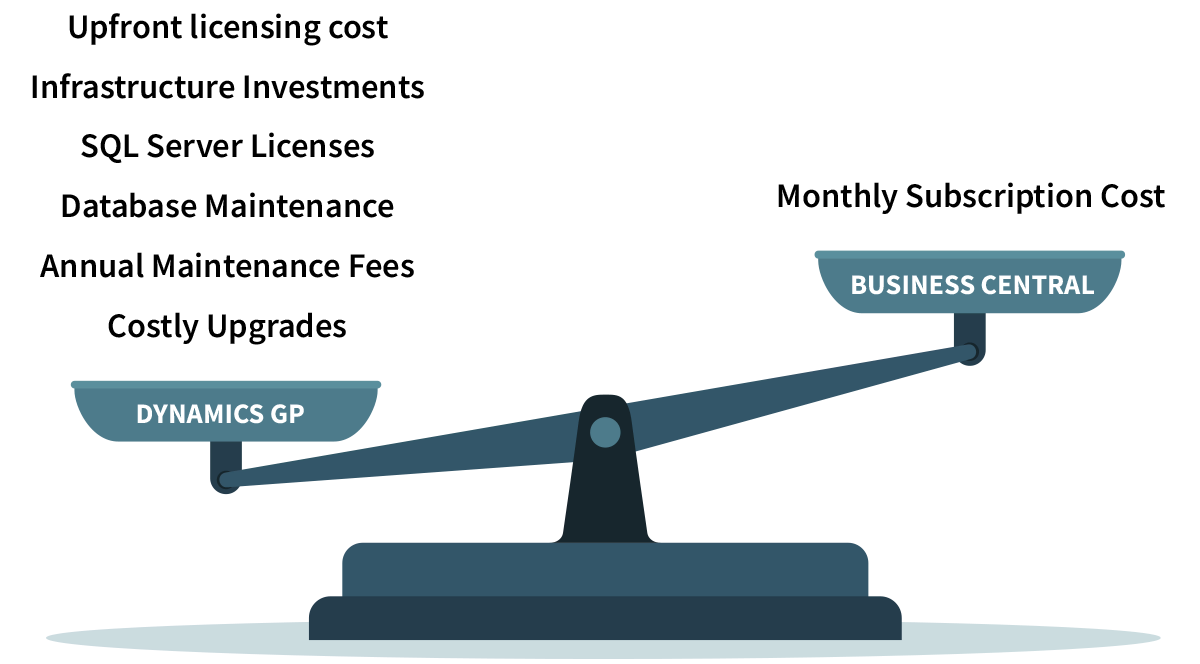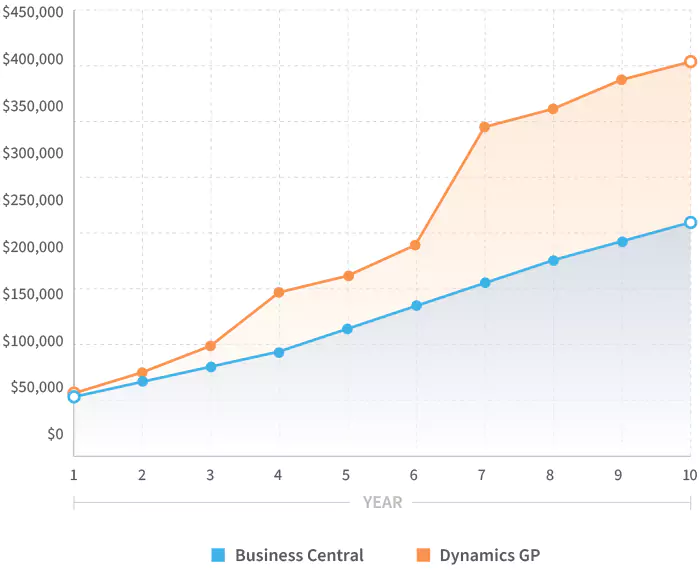Total Cost of Ownership of Dynamics GP vs. Cloud Solutions

Businesses today face a tough choice between on-premises and cloud-based software solutions. As the digital transformation accelerates, the shift towards cloud solutions is gaining momentum. However, it’s essential to understand the overall financial impact of these options on your organization’s bottom line. This blog will undertake an in-depth Total Cost of Ownership (TCO) analysis comparing Dynamics GP, a traditional on-premises ERP solution, and cloud solutions like Dynamics 365 Business Central to help you make an informed decision.
What is Total Cost of Ownership (TCO)?
Total Cost of Ownership (TCO) is a financial estimate intended to help consumers and enterprises determine the direct and indirect costs of a product or system. TCO is not just about the initial purchase price or subscription fees, but also takes into account all the costs related to acquisition, operation, and maintenance over the software’s life.
Calculating TCO is a complex task but paramount to gauge the value and cost-effectiveness of a software solution. Understanding the intricacies of TCO is pivotal for making strategic decisions. By comparing the costs associated with Dynamics GP and cloud solutions such as Dynamics 365, we aim to empower businesses with the insights needed to align their technology investments with long-term objectives.
TCO of Dynamics GP vs Cloud Solutions
Navigating the cost considerations of ERP solutions requires a comprehensive understanding of both on-premises and cloud-based options. Dynamics GP, as an on-premises ERP solution, demands substantial upfront investments in infrastructure, including hardware and servers. Additionally, there are many ongoing maintenance costs.
The most visible ongoing costs are the annual maintenance fees paid to Microsoft, the ongoing cost of servers, and the cost of expensive periodic upgrades. Less visible, but also significant, is the additional IT burden of an on-premise solution which encompasses the cost of server maintenance including software updates, patches, and troubleshooting as well as installing and maintaining the application on desktops or a Citrix environment.
Enhancement Plans
Dynamics GP customers pay for an annual enhancement plan which entitles them to Microsoft support as well as hotfixes and updates. Historically, the Enhancement Plan was 16% of the value of a company’s Dynamics GP license and the Advantage Plan was 18% of the value. In 2022, Microsoft increased this rate from 16% to 17% and from 18% to 19%. In October 2023, the rate was increased again to 18% and 20% respectively.
With a list price of $3,000 per user, this means that a company on Dynamics GP is paying $540 to $600 a year per user on enhancement plans, or $45 to $50 a month.
In contrast, the list price for a subscription to Dynamics 365 Business Central for one user is $70 per month. However, Microsoft is currently offering a discount of 40% to Dynamics GP clients, which reduces the monthly cost per user to $42, which is actually lower than the cost of a Dynamics GP enhancement plan, and includes much more.
Infrastructure Cost
All Dynamics GP customers pay for infrastructure cost, one way or another, whether your instance of Dynamics GP is on physical servers on-premise, servers in a data center, or servers in Azure.
If you utilize physical servers, you must factor in the cost of the physical server, costs for power and cooling to maintain the servers, and the cost of replacing the servers once they have reached their end of life. If you pay for servers in a data center or servers in Azure, you must include the ongoing fees associated with those resources, which could range from $100s a month to $1000s depending on the size and complexity of your GP infrastructure.
For all server options, there are also the associated costs of software licensing for the servers (Windows Server, SQL Server etc.) and the IT costs of maintaining the servers and making sure they are optimized, secure, and have the latest updates applied.
Additionally, most companies have additional infrastructure cost associated with making Dynamics GP more accessible to users such as Citrix, VPN, or Remote Desktop.
A cloud ERP solution completely eliminates the needs to pay for all of the infrastructure costs listed above, allowing your business to redirect those funds towards other initiatives.
Cloud ERP TCO
In contrast, cloud solutions, such as Dynamics 365 Business Central, offer one, all-inclusive monthly price, negating a large upfront investment and substantial ongoing maintenance costs, revolutionizing the cost paradigm. Operating on a subscription model, they offer flexibility with scalable, recurring fees, aligning costs with actual usage. Eliminating upfront hardware costs, cloud solutions transfer infrastructure maintenance responsibilities to the service provider, reducing capital expenditure and ongoing hardware expenses.
- Subscription-based model offers more flexibility in terms of payment
- No hardware costs, shifting the burden of maintaining services and infrastructure to the cloud service provider
- Streamlined operational models reduce the need for extensive in-house or outsourced IT support, resulting in lower IT staff costs
- Scalability becomes a key advantage, allowing organizations to adjust subscription plans according to dynamic business needs, optimizing resource utilization and cost-effectiveness
- Streamlined upgrades enhance operational efficiency, ensuring organizations stay current without incurring complex and costly processes

Upfront Licensing Cost
Infrastructure Investments
SQL Server Licenses
Database Maintenance
Annual Maintenance Fees
Costly Upgrades
Monthly Subscription Cost
Comparing the TCO of Dynamics GP with that of cloud solutions reveals a compelling narrative. While Dynamics GP offers ownership benefits, the long-term financial implications can be substantial. Cloud solutions, such as Dynamics 365 Business Central, often present a more cost-effective alternative. The table below compares the TCO for Dynamics GP vs Business Central, a popular cloud-based ERP system, addressing key aspects, such as subscription costs, hardware expenses, and scalability.
* For a limited time Microsoft is offering loyal Dynamics GP customers Business Central at a discounted rate of $42 per user per month. This is actually lower than the average GP annual maintenance fee which is typically around $600 a user per year (or $50 per month) and includes much more.
Note: The TCO factors mentioned in the table are qualitative representations, and the actual costs may vary based on specific organizational needs and dynamics. Organizations are encouraged to conduct a thorough analysis based on their unique requirements and circumstances.
Cost of personnel who manage and support the software including salaries and benefits.
Cost of staying on GP vs migrating to a Cloud Solution
Understanding the Total Cost of Ownership (TCO) of your current software investments is vital to making informed decisions about the future of your IT infrastructure. In this context, if you’re using Dynamics GP and considering a migration to a cloud solution like Dynamics 365 Business Central, it’s essential to compare the TCO of both these scenarios over time. These systems bring differing values and cost structures as detailed in the line graph below.
TCO of Dynamics GP vs Business Central
This line graph compares the TCO of maintaining your current Dynamics GP instance against migrating to Dynamics 365 Business Central over a multi-year timeline.
For the existing Dynamics GP instance, costs involve substantial cost due to infrastructure investment, software licensing, and support services which continue to escalate as your business grows and as the software warrants upgrades. This leads to a steeper incline in its TCO line, reflecting the increasing long-term financial commitment. On the other hand, migrating to Dynamics 365 Business Central requires costs for initial migration and then offers a more predictable, gradual increase in costs due to its cloud-based, subscription model. Also, upgrades, which are more streamlined, do not result in sudden cost spikes. As a result, the TCO line for Dynamics 365 Business Central illustrates a more gradual upward trend.
This comparison underscores the potential long-term financial benefits of migrating from Dynamics GP to Dynamics 365 Business Central. While there’s an upfront cost to make the switch, the overall TCO of Dynamics 365 Business Central proves to be less imposing with lower costs that scale more gradually over time. This illustrates how migrating to Dynamics 365 Business Central can offer a more sustainable financial trajectory.
Optimize your ERP investment with Rand Group
Navigating the Total Cost of Ownership (TCO) landscape requires a strategic approach, especially when considering a transition from legacy systems like Dynamics GP to newer, more agile solutions. At Rand Group, we specialize in assisting clients in evaluating their current systems and making informed decisions about adopting new solutions. Here’s how we can help you calculate the TCO and make the transition seamlessly:
- TCO Analysis: Our team at Rand Group excels in performing TCO analyses for clients, providing a comprehensive understanding of the financial implications of their current system and potential alternatives.
- Evaluation and Selection: We understand that every business has unique requirements. Our team helps in evaluating and identifying the best ERP system to meet these needs, thereby ensuring that the system will deliver the greatest return on investment.
- Migration and Implementation Services: Transitioning to a new ERP system can seem daunting. Rand Group is committed to making this process smooth with its reliable migration and implementation services. Our experienced team ensures a seamless transition from your existing Dynamics GP system to the new ERP, minimizing downtime and disruption and setting you up for success right from the start.
- Comprehensive Support: Post-implementation, we offer comprehensive support to ensure that your system runs smoothly, updates are managed efficiently, and any issues are resolved swiftly. With Rand Group, you can focus more on leveraging your ERP to drive business success!
By leveraging Rand Group’s services, businesses can make well-informed decisions about their technology investments, ensuring that the chosen solution aligns with their strategic goals while minimizing the overall Total Cost of Ownership. Our commitment to providing comprehensive solutions extends beyond the analysis phase, supporting clients throughout their journey to a more efficient and cost-effective technology landscape.
Next steps
Dynamics GP has been a trusted ERP for many, but the evolving dynamics of technology have ushered in cloud solutions like Dynamics 365 Business Central. The TCO analysis suggests that cloud solutions can provide a financially savvy and operationally efficient pathway forward. For more information or a free consultation to discuss your current systems, contact Rand Group today.






